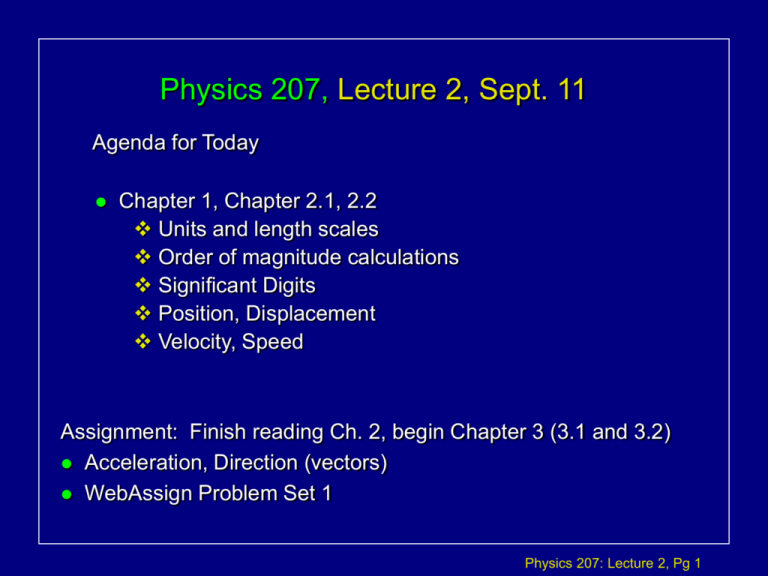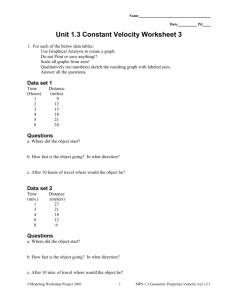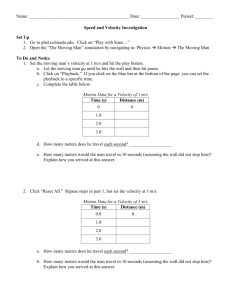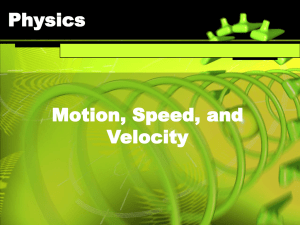Physics 207: Lecture 2 Notes
advertisement

Physics 207, Lecture 2, Sept. 11 Agenda for Today Chapter 1, Chapter 2.1, 2.2 Units and length scales Order of magnitude calculations Significant Digits Position, Displacement Velocity, Speed Assignment: Finish reading Ch. 2, begin Chapter 3 (3.1 and 3.2) Acceleration, Direction (vectors) WebAssign Problem Set 1 Physics 207: Lecture 2, Pg 1 Length: Distance Radius of Visible Universe To Andromeda Galaxy To nearest star Earth to Sun Radius of Earth Sears Tower Football Field Tall person Thickness of paper Wavelength of blue light Diameter of hydrogen atom Diameter of proton Length (m) 1 x 1026 2 x 1022 4 x 1016 1.5 x 1011 6.4 x 106 4.5 x 102 1.0 x 102 2 x 100 1 x 10-4 4 x 10-7 1 x 10-10 1 x 10-15 Physics 207: Lecture 2, Pg 2 Order of Magnitude Calculations / Estimates Questions: What is the earth’s radius in meters? Need to know something from your experience: Flying from NYC to SF one accumulates ~ 3,000 miles NYC to SF spans about 1/8 of the Earth’s circumference So, the Earth’s circumference L = 3,000 x 8 ~ 24,000 mi Since circumference of a circle is : L = 2 r Estimate of Earth radius : L 24,000 mi r 4,000 mi 2 6 4 x 103 mi = 4 x 103 mi x1.6 km/mi x10 m/km ~ 6.4x103 km = 6x106 m Physics 207: Lecture 2, Pg 3 Time: Interval Age of Universe Age of Grand Canyon Avg age of college student One year One hour Light travel from Earth to Moon One cycle of guitar A string One cycle of FM radio wave One cycle of visible light Time for light to cross a proton Time (s) 5 x 1017 3 x 1014 6.3 x 108 3.2 x 107 3.6 x 103 1.3 x 100 2 x 10-3 6 x 10-8 1 x 10-15 1 x 10-24 Physics 207: Lecture 2, Pg 4 Mass: Object Visible universe Milky Way galaxy Sun Earth Boeing 747 Car Student Dust particle Bacterium Proton Electron Mass (kg) ~ 1052 7 x 1041 2 x 1030 6 x 1024 4 x 105 1 x 103 7 x 101 1 x 10-9 1 x 10-15 2 x 10-27 9 x 10-31 Physics 207: Lecture 2, Pg 5 Some Prefixes for Power of Ten Power 10-18 10-15 10-12 10-9 10-6 10-3 Prefix atto femto pico nano micro milli 103 106 109 1012 1015 1018 kilo mega giga tera peta exa Abbreviation a f p n m m k M G T P E Physics 207: Lecture 2, Pg 6 See text : 1-3 Density Every substance has a density, designated = M/V • Dimensions of density are, • Some examples, Substance Gold Lead Aluminum Water M L3 units (kg/m3) (103 kg/m3) 19.3 11.3 2.70 1.00 Physics 207: Lecture 2, Pg 7 See text : 1-3 Atomic Density In dealing with macroscopic numbers of atoms (and similar small particles) we often use a convenient quantity called Avogadro’s Number, NA = 6.023 x 1023 atoms per mole Commonly used mass units in regards to elements 1. Molar Mass = mass in grams of one mole of the substance (averaging over natural isotope occurrences) 2. Atomic Mass = mass in u (a.m.u.) of one atom of a substance. It is approximately the total number of protons and neutrons in one atom of that substance. 1u = 1.660 538 7 x 10-27 kg What is the mass of a single carbon (C12) atom ? 12. g/mol -23 g/atom M (carbon) = 2 x 10 6.023 10 23 atom/mol Physics 207: Lecture 2, Pg 8 See text : 1-4 Dimensional Analysis This is a very important tool to check your work Provides a reality check (if dimensional analysis fails then no sense in putting in the numbers; this leads to the GIGO paradigm) Example When working a problem you get the answer for distance d = v t 2 ( velocity x time2 ) Quantity on left side = L Quantity on right side = L / T x T2 = L x T Left units and right units don’t match, so answer is nonsense Physics 207: Lecture 2, Pg 9 Text : 1-5 Converting between different systems of units Useful Conversion factors: 1 inch = 2.54 cm 1m = 3.28 ft 1 mile = 5280 ft 1 mile = 1.61 km Example: Convert miles per hour to meters per second: mi 1 mi 5280 ft 1m 1 hr m 1m 1 0.447 hr hr mi 3.28 ft 3600 s s 2 s Physics 207: Lecture 2, Pg 10 Lecture 2, Exercise 2 Converting between different systems of units When on travel in Europe you rent a small car which consumes 6 liters of gasoline per 100 km. What is the MPG of the car ? (There are 3.8 liters per gallon.) 100 km 100 km mi 3.8 l mi mi 39.6 40 6 l 6 l 1.6 km gal gal gal Physics 207: Lecture 2, Pg 11 See text : 1-7 Significant Figures The number of digits that have merit in a measurement or calculation. When writing a number, all non-zero digits are significant. Zeros may or may not be significant. those used to position the decimal point are not significant (unless followed by a decimal point) those used to position powers of ten ordinals may or may not be significant. In scientific notation all digits are significant Examples: 2 1 sig fig 40 ambiguous, could be 1 or 2 sig figs (use scientific notations) 4.0 x 101 2 significant figures 0.0031 2 significant figures 3.03 3 significant figures Physics 207: Lecture 2, Pg 12 See text : 1-7 Significant Figures When multiplying or dividing, the answer should have the same number of significant figures as the least accurate of the quantities in the calculation. When adding or subtracting, the number of digits to the right of the decimal point should equal that of the term in the sum or difference that has the smallest number of digits to the right of the decimal point. Examples: 2 x 3.1 = 6 4.0 x 101 / 2.04 x 102 = 1.6 X 10-1 2.4 – 0.0023 = 2.4 End of Chapter 1 Physics 207: Lecture 2, Pg 13 Motion in One-Dimension (Kinematics) Position / Displacement Position is measured and referenced to an origin: 10 meters Joe is 10 feet to the right of the lamp origin = lamp direction = to the right position vector : -x +x 10 meters O Joe Physics 207: Lecture 2, Pg 14 Position / Displacement Displacement is just change in position. X = xf - xi 15 meters 10 meters xi xf Joe O x = 5 meters Physics 207: Lecture 2, Pg 15 Average speed and velocity Changes in position vs Changes in time • Average velocity = total distance covered per total time, x( total displaceme nt ) vaverage velocity t ( total time ) Speed is just the magnitude of velocity. The “how fast” without the direction. Active Figure 1 • http://www.phy.ntnu.edu.tw/ntnujava/main.php?t=282 Instantaneous velocity, velocity at a given instant x(displaceme nt ) dx vvelocity t 0 t ( time ) dt lim Active Figure 2 http://www.phy.ntnu.edu.tw/ntnujava/main.php?t=230 Physics 207: Lecture 2, Pg 16 Recap If the position x is known as a function of time, then we can find both velocity v x x(t ) dx v dt t1 x t v x dt v(t ) t0 t Physics 207: Lecture 2, Pg 17 Recap of today’s lecture Measurement and units (chapter 1) Systems of units Density Converting between systems of units Dimensional Analysis Position and displacement Velocity and speed (Text: (Text: (Text: (Text: 1.1) 1.3) 1.5) 1.4) Reading for Wednesday’s class 9/13/06: » All of Chapter 2 » Chapter 3.1, 3.2 » Begin WebAssign Homework #1: Physics 207: Lecture 2, Pg 18




